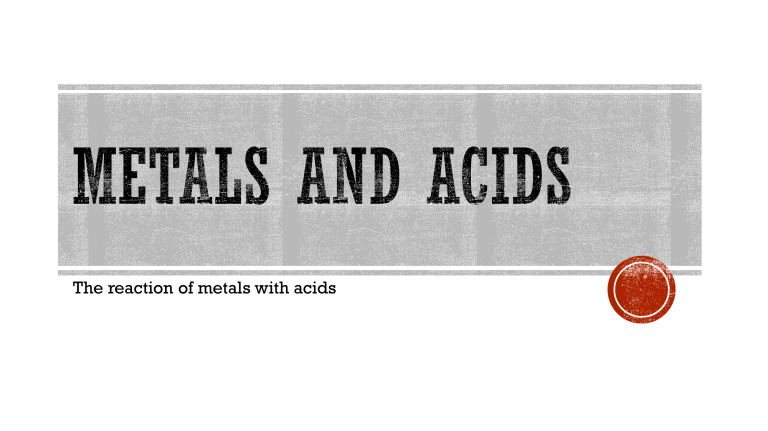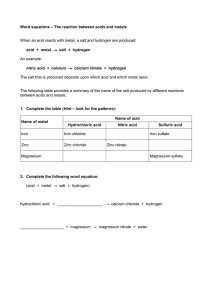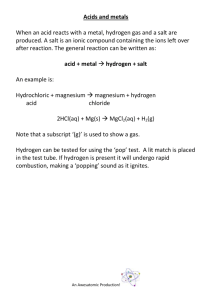The reaction of metals with acids
advertisement

The reaction of metals with acids Revision questions: To compare the reactions of different metals with dilute acids To explain the test for hydrogen gas To decide which metals react more vigorously from practical observations Key words: Metals, acids, pH, salt, squeaky pop test Where would you find the metals from the periodic table of elements? Which group are they in? What are the properties of metals? An acidic substance has a pH of less than 7. How do we tell? Use an indicator! Acids will react with an alkali (substance with pH above 7) to always form salt and water! The most common ones you’ll need to know in your syllabus are: Hydrochloric acid (HCl) Sulfuric acid (H2SO4) Nitric acids (HNO3) https://www.youtube.com/watch?v=Na_6j9y9ke8 When you add an acid to a metal, a colourless and odourless gas is produced. Can you guess what it is? Hydrogen gas! The fizzing or bubbling that you’ve noticed is actually hydrogen gas being produced from the reaction between the acid and metal and released to the atmosphere. This shows that a chemical reaction has occurred! Other observations that you can make is the dissolving of the metal. What do you think is going on in these experiments? Acid + metal salt + hydrogen e.g. Hydrochloric acid + sodium sodium chloride + hydrogen Note: name of the salt is determined by type of metal and name of acid used in the reaction. Always start with the metal followed by the acid. If we use hydrochloric acid, the salt will be a chloride If we use sulfuric acid, the salt will be a sulphate If we use nitric acid, the salt will be a nitrate Note: a salt is a substance produced from the reaction of a metal or metal compound with acid. The salt contains the metal and the parts leftover when the hydrogen is released from the acid. The salt that you consume (table salt) is actually sodium chloride. Please don’t try to eat other salts as they may be poisonous! Let’s look at a few examples: Magnesium + hydrochloric acid magnesium chloride + hydrogen * If we use hydrochloric acid, the salt will be a chloride Magnesium + sulfuric acid magnesium sulphate + hydrogen * If we use sulfuric acid, the salt will be a sulphate Magnesium + nitric acid magnesium nitrate + hydrogen * If we use nitric acid, the salt will be a nitrate We’re now quite familiar with word equations, but what about symbol equations? e.g. Hydrochloric acid + sodium HCl(aq) + Na(s) sodium chloride + hydrogen NaCl(aq) + H2(g) First, you’ll need to know the symbols for the metals (periodic table) and for the acids. To know the ratios of the metals to the chloride/sulphate/nitrate ions in the salt, just remember: For HCl: Group 1 1:1 For HNO3: Group 1 1:1 For H2SO4: Group 1 2:1 Group 2 1:2 Group 2 1:2 Group 2 1:1 Group 3 1:3 Group 3 1:3 Group 3 2:3 We’re now quite familiar with word equations, but what about symbol equations? e.g. Hydrochloric acid + sodium HCl(aq) + Na(s) sodium chloride + hydrogen NaCl(aq) + H2(g) Then you’ll need to know which group the metals are in to know the ratios of acids to metals. For HCl: Group 1 1:1 For HNO3: Group 1 1:1 For H2SO4: Group 1 1:2 Group 2 2:1 Group 2 2:1 Group 2 1:1 Group 3 3:1 Group 3 3:1 Group 3 3:2 We’re now quite familiar with word equations, but what about symbol equations? e.g. Hydrochloric acid + sodium HCl(aq) + Na(s) sodium chloride + hydrogen NaCl(aq) + H2(g) (s), (l), (aq) and (g) are state symbols. Basically: (s) = solid (l) = liquid (liquid must be a pure substance (aq) = aqueous (solution made with water) (g) = gas Let’s look at a few examples: Magnesium + hydrochloric acid Mg(s) + 2HCl(aq) Magnesium + sulfuric acid Mg(s) + H2SO4(aq) Magnesium + nitric acid Mg(s) + 2HNO3(aq) magnesium chloride + hydrogen MgCl2(aq) + H2(g) magnesium sulphate + hydrogen MgSO4(aq) + H2(g) magnesium nitrate + hydrogen Mg(NO3)2(aq) + H2(g) When you add an acid to a metal, a colourless and odourless gas is produced. Can you guess what it is? Hydrogen gas! The fizzing or bubbling that you’ve noticed is actually hydrogen gas being produced from the reaction between the acid and metal and released to the atmosphere. But how do we tell if it really is hydrogen? All you need is a lighted splint. If it burns and goes out with a ‘pop’ you know it is hydrogen gas! What is happening? Hydrogen + oxygen water You’ve seen that some metals react very vigorously with the dilute acids. You know this by the large amounts of hydrogen released quickly during the reaction (a lot of fizzing/bubbling) E.g. magnesium, calcium, potassium Some metals do not react as vigorously with the dilute acids (less fizzing/bubbling) E.g. zinc, iron, lead Some don’t react with acids at all! (no reaction/ no fizzing)E.g. copper, gold and silver This is all due to reactivity! We’ll discuss what this is later on in the topic. Metals react with acids to form salt and water The named of the salt depends on the type of metal and acid used Some metals react violently with dilute acids, while others react less vigorously. Some do not react at all. We learnt how to write word equations We learnt a little about writing symbol equations and state symbols https://www.youtube.com/watch?v=9hBCLoWwcWo https://www.bbc.co.uk/education/guides/zqwmxnb/revision/2 https://www.youtube.com/watch?v=b1JtmFQzY4Y





